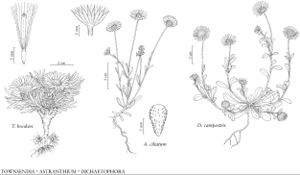Dichaetophora
Mem. Amer. Acad. Arts, n. s. 4: 73. 1849.
| Taxon | Illustrator ⠉ | |
|---|---|---|
 | Townsendia hookeri Astranthium ciliatum Dichaetophora campestris | Yevonn Wilson-Ramsey Barbara Alongi Barbara Alongi |
Annuals, 4–24 cm (taprooted). Stems erect or decumbent, simple or branched, sparsely strigose. Leaves basal and cauline; alternate; petiolate to subpetiolate; blades 1-nerved, oblanceolate, margins entire, apices mostly obtuse, faces sparsely strigose. Heads radiate, borne singly. Involucres hemispheric, (3–4.5 ×) 5–7 mm. Phyllaries 16–25 in 2 series, 1-nerved (midnerves not evident; flat), broadly oblanceolate to lanceolate, subequal, margins broadly scarious, hyaline (apices acute to obtuse), glabrous. Receptacles convex to conic, smooth, epaleate. Ray-florets 15–25, pistillate, fertile; corollas lavender-tinged abaxially, white adaxially, and often drying with a bluish purple midstripe. Disc-florets (20–) 45–75, bisexual, fertile; corollas yellow, abruptly contracted, tubes shorter than narrowly tubular throats, lobes 5, erect, triangular; style-branch appendages lanceolate-acute. Cypselae (brownish) obovoid to widely ellipsoid, strongly compressed, margins pale, winglike, piloso-ciliate, body faces sparsely pilose (hairs apically glochidiate), wings glabrous; pappi of 2 ascending, thin, barbellate awns, usually plus elliptic ring of shorter awns. x = 3.
Discussion
Species 1.
Dichaetophora is characterized by its annual habit, oblanceolate leaves, small, white-rayed heads, and broadly scarious-margined phyllaries. The cypselae are primarily 2-awned and have glochidiate hairs (each apical cell abruptly reflexed, together forming a pronged structure) covering the faces and the winged margins. Dichaetophora is similar and apparently closely related to Astranthium; it has the same chromosome number (2n = 6) as northern species of Astranthium. D. S. Correll and M. C. Johnston (1970) commented that Astranthium integrifolium and Dichaetophora are separated by a “few technical differences in achene and pappus...” and “almost certainly... should be congeneric.” This may prove to be the case, but inclusion of the winged and awned cypselae of Dichaetophora would alter the morphologic integrity of Astranthium, and more definitive evidence is needed.
Selected References
Lower Taxa
"[" is not declared as a valid unit of measurement for this property."]" is not declared as a valid unit of measurement for this property.